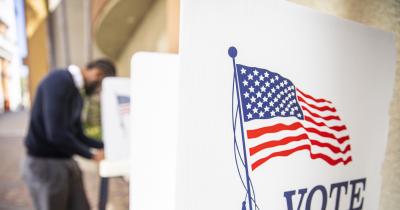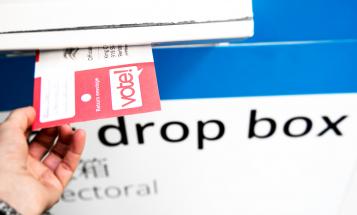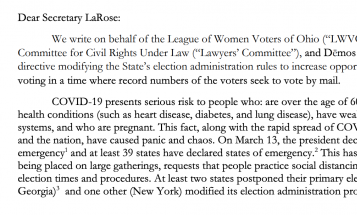
Ohio's Primary Is a Mess: How the State Is Restricting the Vote during the COVID Crisis (And What We're Doing About It)
The Ohio legislature created a wholly avoidable, overly complicated situation that makes Ohioans jump through hoops to vote. Ohio voters: we want to hear about your experience.

Ohio’s primary election is currently scheduled to end on April 28. While the number of voters who will be disenfranchised in that election has yet to be seen, the right to vote for hundreds of thousands of registered and eligible Ohio voters is currently in jeopardy. This situation—created by the Ohio legislature—was avoidable.
How Did We Get Here?
Ohio’s primary election was originally slated to take place on March 17. Based on previous participation rates, it was estimated that approximately 85 percent of the voters casting a ballot in the primary would do so on Election Day. However, on the evening of March 16, the director of the Ohio Department of Health required that polling places be closed “to avoid the imminent threat” posed by COVID-19, and the Secretary of State moved the date of the Election to June 2.
A lawsuit was brought challenging the Secretary of State’s power to set a new election date and asking the Ohio Supreme Court to move the election up to April 28. While that case was pending, the Ohio legislature stepped in and—ignoring statements from the Secretary of State and the bipartisan Ohio Association of Election Officials (OAEO) that April 28 was too soon to conclude the election and not logistically possible—enacted legislation that set the primary for April 28.
H.B. 197 requires Ohio voters to jump through a series of hoops in order to cast a ballot.
That legislation, House Bill 197, was wrapped into a broad coronavirus relief package and moved Ohio’s 2020 primary to a vote-by-mail election. H.B. 197 requires Ohio voters to jump through a series of hoops in order to cast a ballot:
- First, H.B. 197 requires the Secretary of State to design, print, and send a postcard to each of the 7.7 million people registered to vote in Ohio, informing them that they need to submit an application for an absentee ballot;
- Second, voters need to obtain postage and an envelope to submit a written absentee ballot application to their board of elections—the state is not directly sending them applications;
- Third, if the application is correctly filled out, the state will send the voter their ballot (if not, voters must re-submit an application); and
- Fourth, voters must fill out their ballot and return it to the board, either postmarking it by April 27 or returning it to the board on April 28.
[E]ach mailing can take 3-5 days, leaving little to no room for errors in the application process, which are common in Ohio.
As the OAEO noted, each mailing can take 3-5 days, leaving little to no room for errors in the application process, which are common in Ohio. In other words, voters have to perfectly execute multiple steps, and any error or delay in the mail may result in them not being able to vote. This burden falls particularly hard on voters who cannot print their own ballot applications or who lack the postage to mail them. It also creates especially acute problems for college students who have been forced by the pandemic to leave the state, and now may have to wait longer than the normal period for mail to be delivered.
H.B. 197 also mandated that Ohioans could not register to vote after February 18, 2020. However, the federal National Voter Registration Act (NVRA) requires that individuals be allowed to register to vote not less than30 days before an election. Because H.B. 197 moved the election to April 28 but did not move the registration deadline, it effectively barred people from registering in late February and March despite the NVRA’s requirement.
H.B. 197 was signed into law on Friday, March 27.
Challenging H.B. 197’s Restrictions on the Right to Vote
Demos, along with the Lawyers’ Committee for Civil Rights Under Law and ACLU Ohio, filed a lawsuit challenging the timeline and process set for Ohio’s primary election.
The following Monday, March 30, Demos, along with the Lawyers’ Committee for Civil Rights Under Law and ACLU Ohio, filed a lawsuit challenging the timeline and process set for Ohio’s primary election, on behalf of the Ohio A. Philip Randolph Institute (Ohio APRI), the League of Women Voters of Ohio (LWVO), and 4 Ohio voters.
Ohio APRI and LWVO are non-partisan, civic engagement organizations with members across the state. After Ohio’s March 17 primary was postponed, both organizations found widespread voter confusion about the timeline and process for voting in the primary, and worked diligently to answer voters' questions and help them seek access to the ballot. Both organizations also expressed concern that the timeline for requesting and receiving ballots was simply not long enough and that their members, as well as other Ohio voters, would be denied access to the ballot.
Two of the individual voter plaintiffs similarly worried that the requirement that they apply for a ballot, as well as the time necessary to ultimately cast that ballot, would prevent them from exercising their right to vote. These plaintiffs lacked printers and stamps, which are necessary to submit an application because H.B. 197 did not provide for Ohio to mail ballot applications to voters and instead required voters to procure and send the applications themselves. Given the pandemic, these voters feared seeking out printers and stamps in public; moreover, the entities that traditionally provide printing, like public libraries, are closed due to the pandemic. And even if they submitted an application, the time necessary for elections officials to receive it, process it, mail a ballot, and then for the voters to return those ballots threatened to prevent their votes from being counted by the deadline.
The 2 other individual plaintiffs also had serious concerns about their registrations. One registered to vote after the February 18 deadline, and the other updated her registration after that deadline because she had moved to a new precinct. Under H.B. 197, neither would be able to cast a regular ballot. Similarly, the Ohio Organizing Collaborative noted that the 2,233 Ohioans it registered between February 19 and March 13 would be denied the right to participate in the April 28 primary. H.B. 197’s February 18 registration deadline effectively disenfranchised these registrants despite the fact that they all registered more than 30 days before the April 28 election.
The lawsuit sought relief for each of these affected groups. First, the plaintiffs asked the court to allow any voter who registered within 30 days of the primary election to be permitted to participate. Second, the plaintiffs asked the court to order Ohio to mail absentee ballots directly to voters, rather than mail postcards and require voters to submit ballot applications. (H.B. 197 had effectively moved Ohio’s primary to an all vote-by-mail election, and states that currently hold their elections by mail simply send voters their ballots directly—they do not require voters to apply for the ballots.) This change would have both reduced the barriers to the ballot constructed by H.B. 197 and allowed the election to be administered with greater efficiency. Third, the plaintiffs asked the court to set an election date that would give Ohio elections officials enough time to inform the electorate and administer an orderly election.
On April 3, the federal court decided to let the election proceed as planned, holding that H.B. 197 does warrant changing the registration date and does not impose a severe burden on the right to vote.
What’s Happening Now
Ohio is just weeks away from the mail voting deadline, but Ohio voters are still reporting that many do not know the election is set to conclude in April.
As election administrators and voting rights advocates predicted, Ohio has found itself in a mad rush to administer the election—while board of election employees work staggered shifts and confront extraordinary resource constraints.
Voters in Ohio reported receiving postcards last week, and boards of elections have been receiving requests from voters to have absentee ballot applications sent to them. On April 7 alone, the Franklin County Board of Elections received phone requests for absentee ballot applications from more than 2,200 voters. And in both Franklin County and Hamilton County, it’s been reported that the boards of elections are working with Kroger grocery stores to make absentee ballot applications available in the stores.
Ohio residents are also seeking to help their neighbors access absentee ballot applications in the midst of a public health crisis under the time constraints imposed by H.B. 197. And applications are being printed in newspapers for voters to tear out.
Ohio is just weeks away from the mail voting deadline, but Ohio voters are still reporting that many do not know the election is set to conclude in April.
In the midst of a global pandemic, Ohio should not be creating additional obstacles voters have to navigate to exercise their fundamental right to vote.
You can learn more about this case here.





